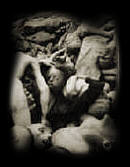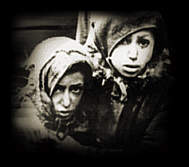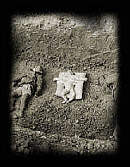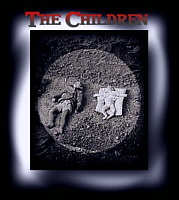Hell of Belzec (original) (raw)

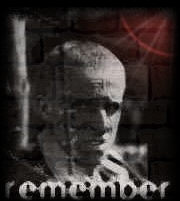


Belzec extermination camp, the model for two others in the 'Aktion Reinhard' murder program, started as a labor camp in April 1940. Belzec was situated in the Lublin district forty-seven miles north of the major city of Lvov, conveniently between the large Jewish populations of south east Poland and eastern Galicia.
The first commandant of Belzec was SS Colonel General Christian Wirth, a former police officer who had played a leading role in implementing the T4 "euthanasiaprogram". Wirth developed his own ideas on the basis of the experience he had gained in the "Euthanasia" program and decided to supply the fixed gas chamber with gas produced by the internal-combustion engine of a motorcar.
Wirth rejected Cyanide B which was later used at Auschwitz. This gas was produced by private firms and its extensive use in Belzec might have aroused suspicion and led to problems of supply. He therefore preferred a system of extermination based on ordinary, universally available gasoline and diesel fuel.
A report by a German officer written in mid-September 1942 describes how Jews rounded up in their villages were packed 200 to each cattle car. The journey to the Belzec deathcamp sometimes took more than a day but no food or water was provided. Throughout the passage, Jews constantly tried to break out through the walls and ceiling of the train cars. Many succeeded but were shot by soldiers guarding the train or hunted down by police units. On several occasions, the train guards used up all their ammunition shooting escaping Jews before the train reached Belzec and had to resort to stones and bayonets.
Many of the transports to Belzec passed through Lvov where the deportees were "processed" for death at the Janowska concentration camp in the town. Jews were marched into the camp assembly ground, ordered to strip naked and marched back to the same transports.
After the arrival men were separated from women and children and marched off to large huts where they undressed. Women had their hair shaven off. They were then brutally pushed to 'the tube' and into the gas chambers which were disguised as 'showers'.

There were four primitive extermination cells. Carbon monoxide gas from diesel engines was pumped in to kill the victims. A conscience-stricken SS officer, Kurt Gerstein, left a rare description of conditions in Belzec. In 1942 Kurt Gerstein was appointed head of the Technical Disinfection Department of the Waffen SS, responsible for improving the efficiency of the gas chambers by procuring the highly toxic prussic acid Zyklon B. In the late summer of 1942 he was sent on a mission to introduce Zyclon B gassing into the Nazi death camps in Poland in place of gas engines.
Kurt Gerstein was deeply shaken by what he witnessed - he had but one desire: to gain an insight into the Nazi death machinery and shout it to the whole world. Eventually he risked his life to inform the Allies. He described how the Jews were forced to undress, the piles of shoes were allegedly 25 meters high, the women's hair was cut off, the naked Jews were driven between two barbed wire fences to the gas chambers. Kurt Gerstein desperately tried to alert the world about the atrocities:
"I see everything! The mothers, their babies at the breast, the little naked children, the men and women, naked. They enter into the death chamber, pushed by the leather whips of the SS. Pack well, that is what the captain ordered. Seven to eight hundred persons on twenty-five square meters. More than half are children ..."
A five-year-old girl dropped a necklace and a three-year-old boy picked it up as they passed into the chamber, where victims were crammed in so tightly they could not move. Men, women, children filed past in ghastly parade as a burly SS man promised in a loud, priestlike voice that nothing terrible was going to happen to them. "All you have to do is breathe in deeply. That strengthens the lungs. Inhaling is a means of preventing infectious diseases. It's a good method of disinfection." To those who timorously asked what their fate would be, the SS man gave more reassurance: the men would build roads and houses, the women would do housework or help in the kitchen.
When the doors closed, the diesel engine would not work but broke down while pumping its deadly carbon monoxide gas into the chamber. While mechanics worked to repair the diesel engine, the Jews had to await death, pressed body-to-body against one another. An SS officer, Wilhelm Pfannenstiel, looking through the glass peep hole in the door of the gas chamber, commented that the Jews were weeping "as they do in the synagogue."
Finally after two hours, it stuttered to life. "Up till then people were alive in these chambers .. another 25 minutes went by. True, many were now dead. After 28 minutes, only a few were still alive. At last after 32 minutes, everyone was dead. Finally, all were dead like pillars of basalt, still erect, not having any place to fall", Kurt Gerstein later wrote.
The outside doors to the gas chamber were opened and the bodies taken out. "One could tell families even in death. They were still holding hands, stiffened in death so that it was difficult to tear them apart to clear the chamber for the next load," Gerstein wrote.
We have another testimony, of one Edward Luczynski from a 1964 trial of German officers: "After the doors were opened, it was often ascertained that some of the children and adults were still alive. Children on the floor and adults with their faces pressed against cracks sometimes managed to survive. The survivors were killed ..."
Teams of Jewish laborers who had been selected from earlier transports then removed the corpses and dragged them to burial pits. Other Jewish workers removed gold teeth from the bodies.
Toward the end of the war, anxious to disguise the evidence of their crime, the Nazis tried to clean out the graves and burn the corpses. They didn't have time to complete the job. That means that underneath the ground that visitors tread on today lie the twisted remains of countless thousands of Jews.
The Belzec extermination center began operations March 17th, 1942 and ended operations December 1942. It is estimated that about 600,000 Jews were murdered at Belzec and probably dozen thousands of Gypsies. Those remaining when the camp ceased to function were transported to Sobibor death camp and murdered.
There were only a handful of survivors of Belzec ..
The commandant of Belzec Christian Wirth was transferred with his superior Odilo Globocnik to Trieste. After Mussolini's overthrow he was to carry out the deportation of Jews. During an official trip to Fiume, Wirth was shot by Yugoslav partisans on 26 May 1944.
www.auschwitz.dk www.oskarschindler.com www.emilieschindler.com www.shoah.dk
� 2011-2013 Louis B�low Privacy
All Rights Reserved.
